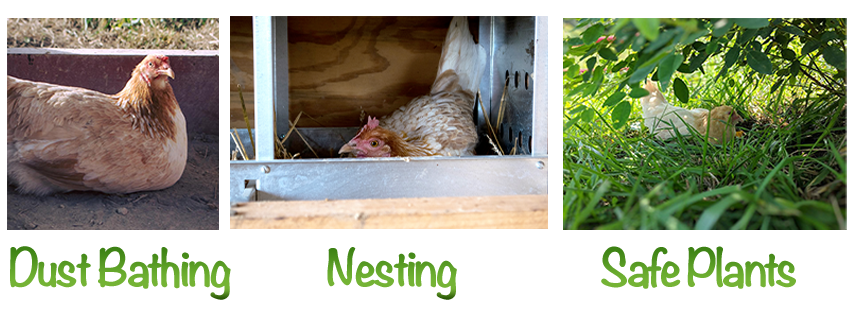Chicken Care 101: Housing

Thinking about adding chickens to your family? In this five-part blog series, we’ll cover the basics to help you decide if bringing chickens into your life is the right choice for both you and the birds. You’ll learn about chicken adoption, safe housing, medical care, proper diet, and the importance of social and emotional care.
In this post, you’ll learn about safe housing for chickens, with a focus on protection from predators and from the elements. Please be sure to read article 1: Adopting Backyard Chickens before making any decisions about rescuing chickens.
Content is provided by Piedmont Farm Animal Refuge, a non-profit rescue and sanctuary for farm animals located in Pittsboro, North Carolina. Open for tours, volunteering, and more. Learn about the Refuge at www.piedmontrefuge.org and find more information at the bottom of this post.
Basic Safety Features
One of the most important, yet often overlooked, elements to providing a safe and happy life for chickens is proper housing. If you plan to house your birds outdoors, there are many considerations to ensure their protection and comfort. If you plan to have your chickens living indoors with you (as many people do!), you may want to consider getting a chicken diaper to help with clean up. There are many options available online, including items from this site. Chickens who live indoors should ensure they get plenty of outdoor time in the sun, as well, but for the remainder of this article, we assume that you plan to house your birds outdoors.
1) Protection from Predators – Chickens are in danger of being injured and/or killed by a large number of animals including dogs, coyotes, opossums, raccoons, foxes, weasels, owls, and hawks. Unfortunately, most chicken housing available for purchase online or at farm stores are terribly inadequate, resulting in thousands of chickens losing their lives from predation each year. The basic components of a safe living space for chickens are as follows:
- Protection from Above – Aviary netting or other protective materials are important to consider for the outdoor area that chickens live in. Hawks and eagles are daytime predators that can easily kill chickens.
- Protection from Below – The floor of a chicken’s nighttime house should either be solid wood and completely raised off the ground or a dirt floor with a perimeter barrier dug underground. Metal flashing and/or fencing should be dug at a depth of at least 3 feet on all sides and secured to a concrete perimeter or other solid perimeter barrier.
- Mind the Gaps – Holes and gaps in the walls or flooring of a chicken house, even spaces as small as a quarter in size, can allow for a predator to enter.
- Materials Matter – Some predators can surprise you with their strength and ingenuity, in particular raccoons. Nighttime housing should be comprised of solid walls, as predators can easily reach through fencing material and pull chickens towards them. Screws are much more secure than nails, which can wiggle and pop out over time. If using metal hardware cloth, it’s important to use heavy-duty metal fencing staples to secure it in place, as smaller gauge staples can easily be pulled out.
2) Room to Roam – Another pitfall of most pre-built chicken houses is their very small size. In these tiny spaces, chickens are susceptible to overheating in the summer months and are generally unhappy to go indoors. The nighttime house should provide at least 4 square feet per bird, and the outdoor daytime space should provide at least 16 square feet per bird. But the more space you can offer, the better!
3) Temperature & Humidity Control – Chickens are fragile animals and require the proper environment to thrive in. In extreme temperatures, they can become ill, sustain injuries, and even die.
- Heat – Heatstroke is common in chickens. Signs of heatstroke include panting with an open mouth, drooling, and holding their wings out from their bodies. Indoor and outdoor areas should provide plenty of shade and access to cool breezes. In most climates, fans in the summer months are a necessity.
- Cold – Chickens are susceptible to frostbite on their legs, toes, and combs. In most climates, heaters in the winter months are a necessity. When temperatures are 40 degrees and below, heaters should be turned on to provide protection and comfort. While heat lamps are often used, they can be a fire hazard if not properly maintained. Ceramic wall mount heaters, such as this product, can be a great option for your birds.
- Humidity – Completely airtight indoor spaces can cause humidity issues for chickens. Water vapor from the air and from the chickens exhaling can create health problems, including pneumonia and other respiratory issues. Finding a balance of a predator-proof house with a house that provides ventilation can be tricky. Metal hardware cloth with quarter inch squares or smaller can be a good option to create windows that could be mostly closed on very cold days. However even in cold temperatures, it’s important to provide some kind of ventilation in your chicken house.
Building for Birds
It’s important to know the natural behaviors and preferences of chickens in order to provide a proper living environment. Did you know that chickens are descended from the Red Junglefowl, a bird that is native to the rainforests of Southeastern Asia? Yep, that’s right, chickens originate from a rainforest environment! In this section, we’ll look at some basic chicken behaviors, likes, and dislikes.
- Perching – In the wild, the ancestors of chickens perch high in trees to protect themselves from nighttime predators. Even when kept in a predator-proof house, chickens have a strong instinct to perch at night and will make every attempt to do so. To appease them, it’s best to provide a wooden perch, similar to a leaning ladder, with plenty of space for all of the birds to choose where to sleep.
- Nesting – Female chickens, called hens, will seek out a quiet, private space to lay their eggs. Metal or wooden nest boxes should be provided for them, and they should have access to these nest boxes at all times. Always provide more nest boxes than the number of hens that you have to ensure that everyone has plenty of options to choose from.
- Dust bathing – Did you know that chickens take dust (not water) baths? This important behavior helps them get rid of external parasites and generally keep their feathers in a healthy condition. Chickens will often make their own dust bath by digging into the dirt and creating a bowl-shaped hole. Despite this, it’s best to provide a covered dust bath for your birds so that in rainy and wet weather they are still able to bathe. Diatomaceous earth or wood ash can be mixed with dirt and placed in a shallow wooden box or surrounded with bricks or pavers. Build a cover for the dust bath, or locate it under a roof or awning to keep it dry.
- Plants – Due to their rainforest origin, chickens prefer a diverse outdoor environment full of trees, bushes, and other plantings. Taller vegetation helps to provide a sense of safety, and plant diversity helps to attract yummy insects. Chickens will also eat a variety of plants and particularly enjoy seed heads and fruits, such as blueberries, jujubes, or mulberries. Consider planting some edibles for both you and your chickens to enjoy! Some plants can be poisonous, so do your research before making any decisions. Some common foods not suitable for chickens include avocados, citrus fruits, onions, and salty items (and many more!).
- Cleanliness – Like most animals, chickens prefer a clean environment, and many health issues can be avoided by regular cleanings. Indoor housing should have a thick layer of bedding on the ground at all times, such as wheat straw or pine shavings. This bedding should be removed and replaced with clean, unsoiled bedding at a minimum of one time per week. The perches and outdoor areas will also need to be spot cleaned to remove droppings and shed feathers regularly.
- Enrichment – Although we will discuss enrichment in further detail in an upcoming post, you may want to consider this an opportunity to install some features that will stimulate your chickens’ minds. For example, install a row of eye bolts on a wall so that a variety of treat feeders could be hung up. Or when running your electrical lines, include an extra outlet that a radio or boom box could be plugged into for your birds’ listening pleasure!
Now that you know the basic features of safe chicken housing, you may be feeling overwhelmed or wondering where to begin. Piedmont Farm Animal Refuge is happy to help get you started on the right track, or to help assess the safety of your existing chicken house. Get in touch with us at the contact information below, and stay tuned for upcoming blog posts on chicken nutrition, enrichment, and more! Have a questions? Contact Piedmont Farm Animal Refuge at info@piedmontrefuge.org.
Content provided by:
Lenore Braford
Founder & Shelter Manager
Piedmont Farm Animal Refuge
www.piedmontrefuge.org
www.facebook.com/PiedmontFarmAnimalRefuge
www.instagram.com/piedmont_farm_animal_refuge


